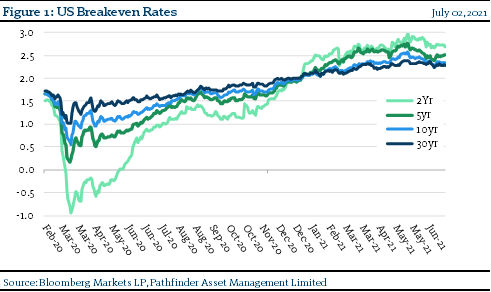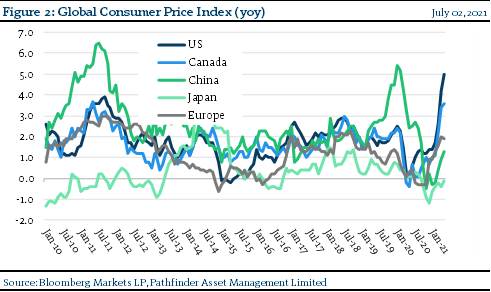Inflation Revisited
In February, we wrote a series of Investment Outlooks dealing with our view on inflation. Please follow the link here to the Information Worth Sharing section of the Pathfinder website for the history of those notes. We wrote that the potential for increase in inflation is a significant question that has implications for all asset classes. The level of interest rates is one of the major inputs used to calculate the intrinsic value of assets, and inflation is a critical part of determining interest rates. This is why market participants pay such close attention to inflation.
We concluded that inflation would be transitory and eventually return to central bank targets. We believe this because the broad impacts from COVID and government mitigation factors will ultimately subside. This means that, in our view, inflation will increase over the coming years and then subsequently normalize. We noted that the major concern for inflation expectations arose from the way businesses have adjusted operating processes, year on year data comparables, central bank activity and global government fiscal response. However, these are ultimately temporary measures and, over time, the situation should normalize.
- Figures 1 and 2 updates the data that we have previously presented. Note in Figure 1 that inflation expectations have shifted from higher to lower as the length of the term increases (blue lines and green lines have swapped places over the last year). This confirms our thesis that increased expectations have been focused on mid-term and not long-term inflation

- Figure 2 presents inflation data for various parts of the world. As you can see, the latest readings show some dispersion in inflation in different parts of the global economy. While the US, Canadian and Japanese numbers are expected, we are surprised that we see limited inflation in Europe, although there has been much lower fiscal stimulus there.

“This means that” we are still following the data very closely. So far, our thesis has played out and it seems the market has priced in the same thesis into fixed income markets. We will continue to be laser focused on this going forward.
National Instrument 31-103 requires registered firms to disclose information that a reasonable investor would expect to know, including any material conflicts with the firm or its representatives. Doug Johnson and/or Pathfinder Asset Management Limited are an insider of companies periodically mentioned in this report. Please visit www.paml.ca for full disclosures.
*All returns are time weighted and net of investment management fees. Returns from the Pathfinder Partners’ Fund and Partners’ Real Return Plus Fund are presented based on the masters series of each fund. The Pathfinder Core: Equity Portfolio and The Pathfinder Core: High Income Portfolio are live accounts. These are actual accounts owned by the Pathfinder Chairman (Equity) and client (High Income) which contain no legacy positions, cash flows or other Pathfinder investment mandates or products. Monthly inception dates for each fund and portfolio are as follows: Pathfinder Core: Equity Portfolio (January 2011), Pathfinder Core: High Income Portfolio (October 2012) Partners’ Fund (April 2011), Partners’ Real Return Plus Fund (April, 2013), and Partners’ Core Plus Fund (November 2014).
Pathfinder Asset Management Limited (PAML) and its affiliates may collectively beneficially own in excess of 10% of one or more classes of the issued and outstanding equity securities mentioned in this newsletter. This publication is intended only to convey information. It is not to be construed as an investment guide or as an offer or solicitation of an offer to buy or sell any of the securities mentioned in it. The author has taken all usual and reasonable precautions to determine that the information contained in this publication has been obtained from sources believed to be reliable and that the procedures used to summarize and analyze such information are based on approved practices and principles in the investment industry. However, the market forces underlying investment value are subject to sudden and dramatic changes and data availability varies from one moment to the next. Consequently, neither the author nor PAML can make any warranty as to the accuracy or completeness of information, analysis or views contained in this publication or their usefulness or suitability in any particular circumstance. You should not undertake any investment or portfolio assessment or other transaction on the basis of this publication, but should first consult your portfolio manager, who can assess all relevant particulars of any proposed investment or transaction. PAML and the author accept no liability of any kind whatsoever or any damages or losses incurred by you as a result of reliance upon or use of this publication.